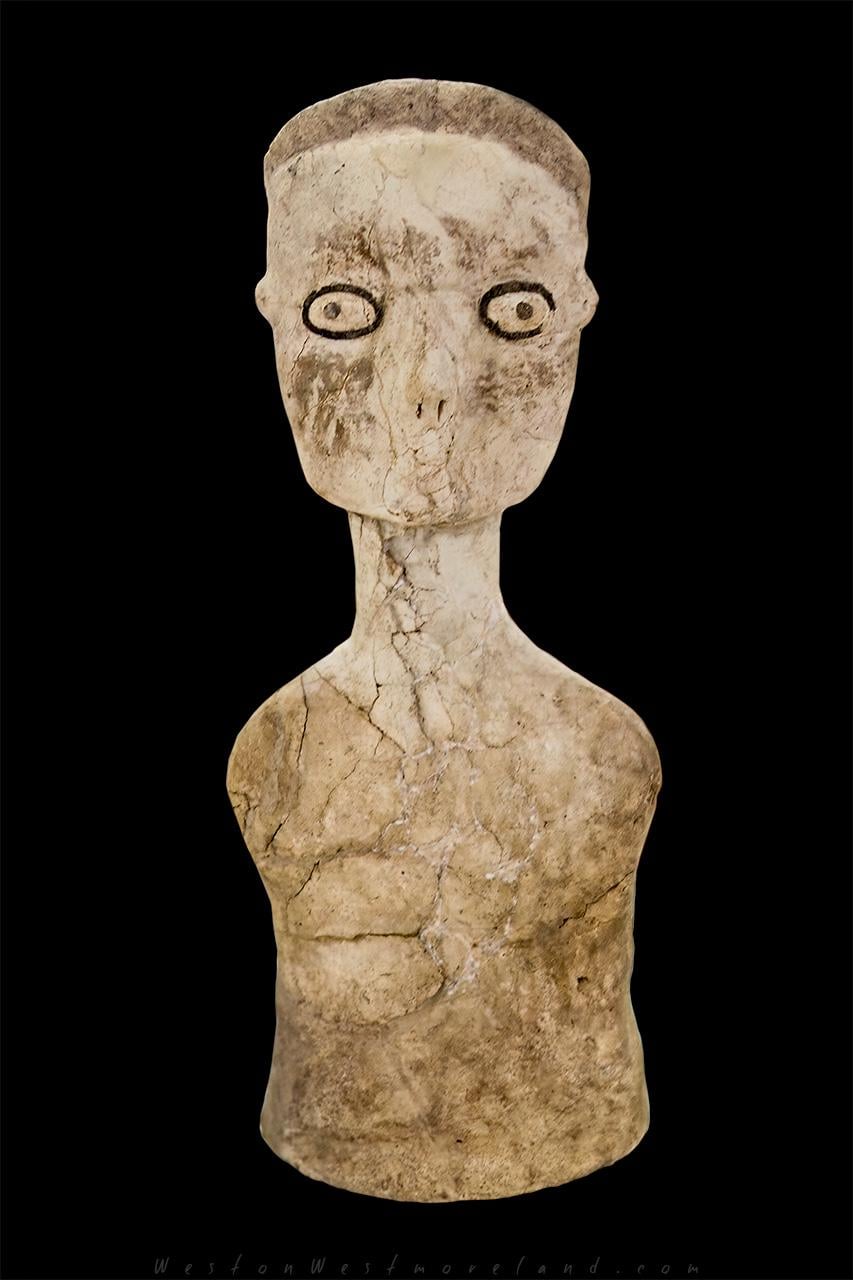
One of the Ain Ghazal statues, large-scale lime plaster and reed statues discovered near Amman, Jordan, made between 7200 and 6250 BCE. Pre-Pottery Neolithic C period. The statues are among the earliest large-scale representations of the human form. Their purpose remains uncertain…[1280×720] [OC]
by WestonWestmoreland

1 Comment
…with archaeologists believing they may have been buried just after production, having possibly been made with that intent.
Ain Ghazal, an archaeological site of a Pre-Pottery Neolithic settlement near Amman, Jordan, was active from about 7250 BCE to about 5000 BCE, during which period the residents transitioned from relying on both wild and domesticated plants for subsistence to becoming a pastoral society.
The village was occupied by a few hundred inhabitants beginning in about 7250 BCE. They lived in individual houses made from field stones covered with mud and lime plaster and painted with a red pigment. After some 300 years, an influx of new inhabitants rather quickly increased the population to 1,600 people, nearly twice what it had been before, and houses began to expand to accommodate multifamily occupation. Over the following 600 years the town continued to grow, and by the end of that period it had become a good-sized metropolis, boasting as many as 2,500 residents. Around 6200–6000 BCE, the village contracted before returning to its previous size.
Studies showed that early inhabitants grew such crops as barley, chickpeas, lentils, and wheat and that they had domesticated goats but that they ate a wide variety of other plants and animals as well. As time went on, however, their diet became limited to those plants and animals that were farmed, showing the beginning of an agrarian way of life. Traces of pottery were also found during the latter part of the town’s existence. DNA evidence indicated that neither farming nor the use of pottery was introduced by a new population, however, but rather that the inhabitants of ʿAin Ghazal achieved these developments on their own. This discovery helped to disprove a widely held theory on how these milestones in human development occurred.
During excavations, archaeologists found numerous figurines that dated from about 6500 BCE, before the development of pottery. Many were small figures of animals, about half of which were aurochs (wild cattle), some of which were depicted as being killed. Other figurines were of pregnant women. The most remarkable statues were those human figures. These statues were found carefully buried in two caches. It was also discovered that some of the village’s dead were buried under the floors of the houses and that a few skulls had been given faces modeled with lime plaster; similar skull molding was noted in other archaeological sites in the Middle East.
The figures are of two types: full statues and busts. Some of the busts are two-headed. Great effort was put into modelling the heads, with wide-open eyes and bitumen-outlined irises. The statues represent men, women and children; women are recognizable by features resembling breasts and slightly enlarged bellies, but neither male nor female sexual characteristics are emphasized, and none of the statues have genitals; the only part of the statues fashioned with any amount of detail is the face.
The statues were formed by modelling moist plaster from limestone on a reed core using plants that grew along the banks of the Zarqa River. The reed decayed over the millennia, leaving plaster shells with hollow interiors. Lime plaster is formed by heating limestone to temperatures between 1,100 and 1,700 °F; hydrated lime is then combined with water to make a dough, which is then modelled. Plaster becomes a water-resistant material when it dries and hardens.
Heads, torsos and legs were formed from separate bundles of reeds which were then assembled and covered in plaster. The irises were outlined with bitumen, and the heads were likely covered with some sort of wig.
They are taller than figurines or statuettes but not human-sized, the tallest statues having a height of close to 3 ft. They are disproportionately flat, about 4 in in thickness. They were nevertheless designed to stand up, probably anchored to the floor in enclosed areas and intended to be seen only from the front. The way the statues were made would not have permitted them to last long, and since they were buried in pristine condition it is possible that they were never on display for any extended period of time, but rather produced for the purpose of intentional burial.
As usual, my apologies for inaccuracies and mistakes.